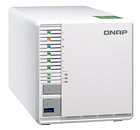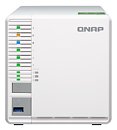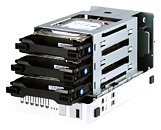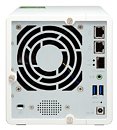- Joined
- Oct 9, 2007
- Messages
- 47,294 (7.53/day)
- Location
- Hyderabad, India
| System Name | RBMK-1000 |
|---|---|
| Processor | AMD Ryzen 7 5700G |
| Motherboard | ASUS ROG Strix B450-E Gaming |
| Cooling | DeepCool Gammax L240 V2 |
| Memory | 2x 8GB G.Skill Sniper X |
| Video Card(s) | Palit GeForce RTX 2080 SUPER GameRock |
| Storage | Western Digital Black NVMe 512GB |
| Display(s) | BenQ 1440p 60 Hz 27-inch |
| Case | Corsair Carbide 100R |
| Audio Device(s) | ASUS SupremeFX S1220A |
| Power Supply | Cooler Master MWE Gold 650W |
| Mouse | ASUS ROG Strix Impact |
| Keyboard | Gamdias Hermes E2 |
| Software | Windows 11 Pro |
QNAP Systems, Inc. today released a new quad-core 3-bay NAS - the TS-332X - that allows for building a RAID 5 array for balancing capacity and protection with the fewest disks. The TS-332X also provides a 10GbE SFP+ port, three M.2 SATA 6Gb/s SSD slots, and supports SSD caching and Qtier auto-tiering technology to help tackle performance-demanding business operations. Featuring a minimalist design, the affordable 10GbE-ready TS-332X can easily fit any commercial space.
The TS-332X is a small NAS, but it is packed full of competitive features," said Dan Lin, Product Manager of QNAP, continuing "It allows for RAID 5 protection in a budget configuration, supports M.2 SATA SSDs, and performs efficient tiered storage. It is a cost-effective 10GbE NAS that empowers even the most budget-conscious small offices to upgrade their entire IT infrastructure."





The TS-332X uses an AnnapurnaLabs, an Amazon company Alpine AL-324 quad-core 1.7 GHz Cortex-A57 processor, features 2GB/4GB DDR4 RAM (upgradable to 16GB), and comes with a 10GbE SFP+ port to provide compatibility with high-speed networks to empower large-data applications, fast backup/restoration, and containerized applications. The TS-332X sports a stylish and elegant look with an industrial design concept to provide effective airflow and cooling, and its tool-less 3.5-inch hard drive installation allows easier system setup and maintenance.
The TS-332X supports up to three SATA 6Gb/s M.2 SSDs with 2280 form factors (sold separately), allowing users to create a high-capacity SSD cache for boosting IOPS-demanding applications, or RAID 5 tiered storage with balanced performance and redundancy protection. Coupled with QNAP's Qtier technology that empowers the NAS with auto tiering, storage efficiency is optimized constantly across M.2 SSDs, 2.5-inch SSDs, and high-capacity HDDs with improved overall system performance.
The TS-332X runs the intelligent QTS operation system that simplifies NAS management with greater flexibility and efficiency. Block-based snapshots enable comprehensive data protection and instant restoration, providing a modern way for users to effectively mitigate the threat of ransomware. As an all-in-one NAS solution for file storage, backup, sharing, synchronization and centralized management, the TS-332X is a productivity boost for daily tasks. Users can install various apps from the App Center to extend NAS functionalities, such as Container Station for LXC and Docker containerized applications, QmailAgent to centralize email account management, and QVR Pro to create a professional video surveillance system (with 8 free IP camera channels, and expandable up to 16 channels with optional licenses).
With VJBOD (Virtual JBOD), the unused storage capacity of TS-332X can be mounted using iSCSI as a virtual disk of other QNAP NAS. It is a great benefit for organizations with multiple QNAP NAS and helps achieve optimal capacity utilization in a cost-effective way.
Key specifications
Availability
The TS-332X NAS is now available.
View at TechPowerUp Main Site
The TS-332X is a small NAS, but it is packed full of competitive features," said Dan Lin, Product Manager of QNAP, continuing "It allows for RAID 5 protection in a budget configuration, supports M.2 SATA SSDs, and performs efficient tiered storage. It is a cost-effective 10GbE NAS that empowers even the most budget-conscious small offices to upgrade their entire IT infrastructure."





The TS-332X uses an AnnapurnaLabs, an Amazon company Alpine AL-324 quad-core 1.7 GHz Cortex-A57 processor, features 2GB/4GB DDR4 RAM (upgradable to 16GB), and comes with a 10GbE SFP+ port to provide compatibility with high-speed networks to empower large-data applications, fast backup/restoration, and containerized applications. The TS-332X sports a stylish and elegant look with an industrial design concept to provide effective airflow and cooling, and its tool-less 3.5-inch hard drive installation allows easier system setup and maintenance.
The TS-332X supports up to three SATA 6Gb/s M.2 SSDs with 2280 form factors (sold separately), allowing users to create a high-capacity SSD cache for boosting IOPS-demanding applications, or RAID 5 tiered storage with balanced performance and redundancy protection. Coupled with QNAP's Qtier technology that empowers the NAS with auto tiering, storage efficiency is optimized constantly across M.2 SSDs, 2.5-inch SSDs, and high-capacity HDDs with improved overall system performance.
The TS-332X runs the intelligent QTS operation system that simplifies NAS management with greater flexibility and efficiency. Block-based snapshots enable comprehensive data protection and instant restoration, providing a modern way for users to effectively mitigate the threat of ransomware. As an all-in-one NAS solution for file storage, backup, sharing, synchronization and centralized management, the TS-332X is a productivity boost for daily tasks. Users can install various apps from the App Center to extend NAS functionalities, such as Container Station for LXC and Docker containerized applications, QmailAgent to centralize email account management, and QVR Pro to create a professional video surveillance system (with 8 free IP camera channels, and expandable up to 16 channels with optional licenses).
With VJBOD (Virtual JBOD), the unused storage capacity of TS-332X can be mounted using iSCSI as a virtual disk of other QNAP NAS. It is a great benefit for organizations with multiple QNAP NAS and helps achieve optimal capacity utilization in a cost-effective way.
Key specifications
- TS-332X-4G: 4GB DDR4 RAM, upgradable to 16GB
- TS-332X-2G: 2GB DDR4 RAM, upgradable to 16GB
Availability
The TS-332X NAS is now available.
View at TechPowerUp Main Site

